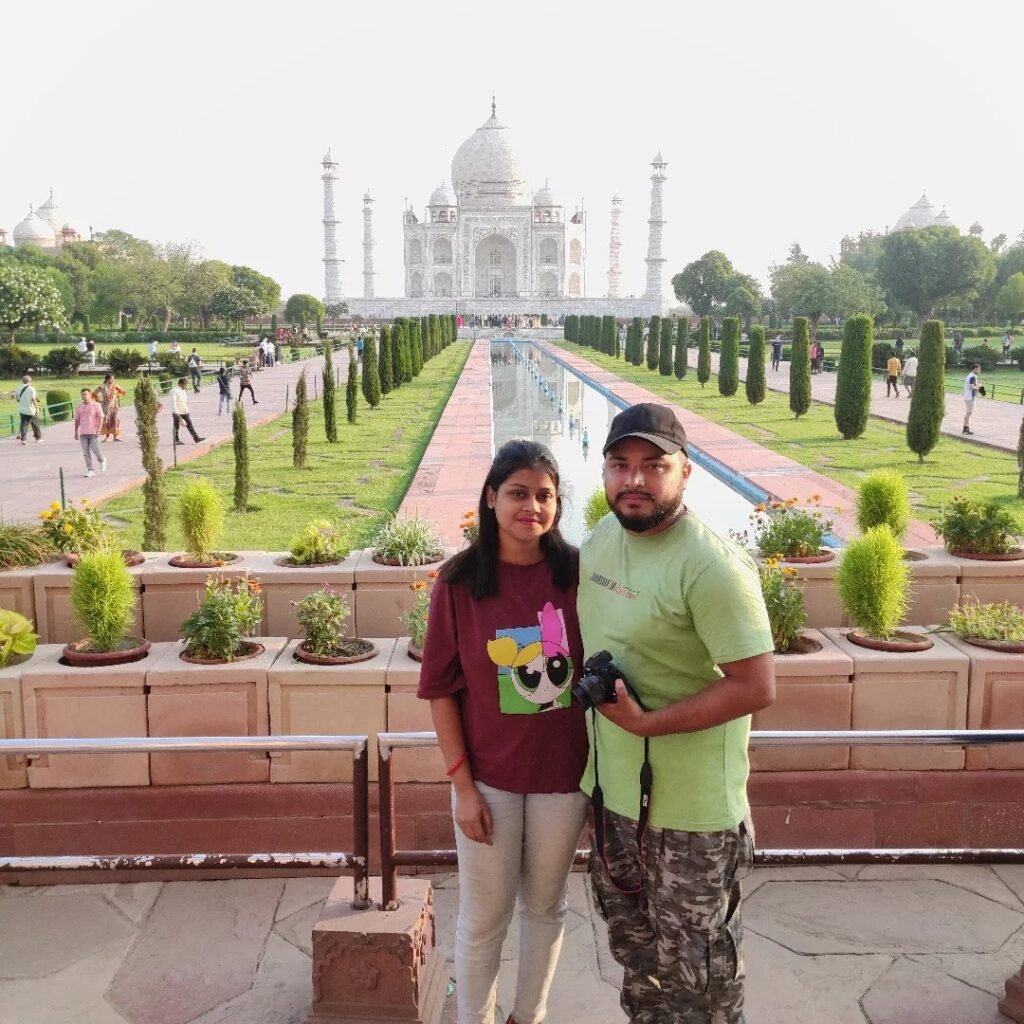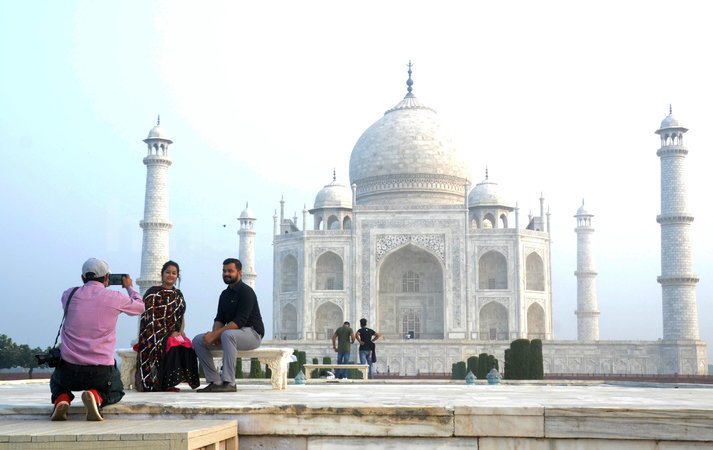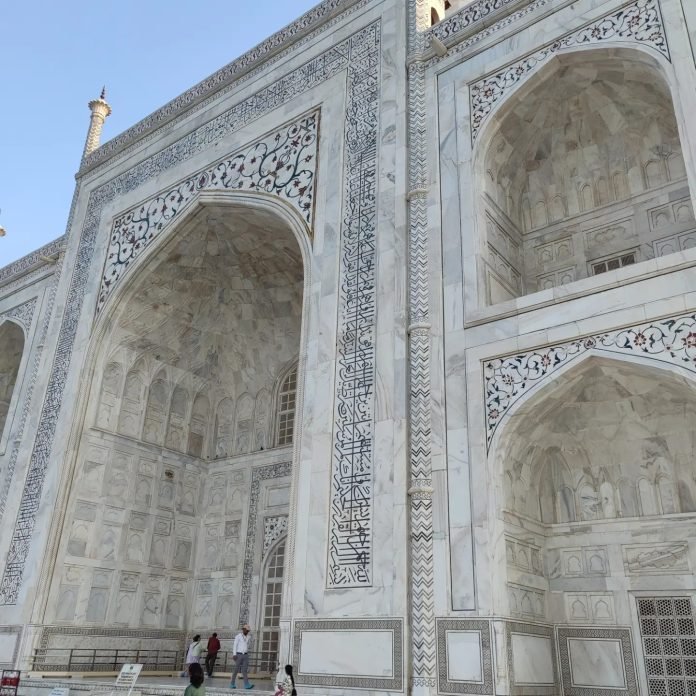Taj Mahal History – The Taj Mahal is one of the most iconic and recognizable landmarks in the world, known for its stunning beauty and intricate architecture. Located in Agra, India, this magnificent monument was built by the Mughal emperor Shah Jahan in memory of his beloved wife, Mumtaz Mahal. Its construction took over 20 years to complete and required the work of thousands of artisans and laborers. According to the Taj Mahal history, the monument was built by over 20,000 skilled craftsmen and artisans who worked tirelessly for over 20 years to create one of the world’s most iconic landmarks.
Taj Mahal history reveals that the monument’s intricate carvings and calligraphy were created using a range of precious stones, including jasper, agate, and turquoise, which were inlaid into the marble.
you also like to read: Private Departure Transfer to Agra from Delhi with English speaking driver
Beyond its breathtaking exterior, the Taj Mahal is steeped in history and fascinating facts. From the challenges faced during its construction to the legends and mysteries that surround it, there is much to discover about this iconic monument. In this comprehensive guide, we’ll explore the history and significance of the Taj Mahal, delve into its unique design and architecture, and highlight some of the interesting facts and legends that make it such a captivating destination. So, let’s uncover the fascinating tale of the Taj Mahal together. Taj Mahal history is a fascinating tale of love, devotion, and architectural excellence that continues to captivate people around the world.

Delhi Agra one day tour by Car – Book with Local Expert From ₹ 6,500
Delhi Agra one day tour by Car Inclusive of neat and clean Car with Experienced Driver + Local Live Guide on Additional cost – Check Out More!
View Details“It is in Taj Mahal history that the monument’s white marble was sourced from various regions of India and Asia, and was transported to the site using a complex system of ramps and pulleys.”
Uncovering the Fascinating Taj Mahal History
According to Taj Mahal History, The Taj Mahal was built in the 17th century by the Mughal emperor Shah Jahan in memory of his beloved wife, Mumtaz Mahal. Mumtaz Mahal passed away in 1631 while giving birth to her 14th child, and Shah Jahan was devastated by her death. He vowed to build a monument that would honor her memory and serve as a testament to their love.
Construction of the Taj Mahal began in 1632 and took over 20 years to complete. The construction involved the work of thousands of artisans and laborers, including architects, calligraphers, and craftsmen from India, Persia, and the Ottoman Empire. The white marble used in the Construction of The Taj Mahal was brought from over 300 kilometers away, and precious stones such as jade, crystal, and turquoise were used to decorate the monument.
Shah Jahan spared no expense in building the Taj Mahal, and it is said that it cost over 32 million rupees at the time. The construction of the Taj Mahal was not without its challenges, and it is said that over 20,000 workers were involved in the project, many of whom lost their lives due to the harsh working conditions.
The Taj Mahal was completed in 1653 and Shah Jahan was laid to rest alongside his beloved wife in the tomb at the center of the monument upon his death in 1666. Today, the Taj Mahal is considered one of the most iconic and beautiful monuments in the world and is recognized as a symbol of love and devotion.
The rich Taj Mahal history is a testament to the skill and craftsmanship of the artisans who built it and the enduring legacy of the Mughal Empire.
Architecture and Design
The Taj Mahal is renowned for its unique and intricate design, which combines elements of Persian, Indian, and Islamic architecture. The monument is made entirely of white marble, which is carved and decorated with intricate patterns and designs.
The Taj Mahal’s most distinctive feature is its central dome, which reaches a height of 73 meters (240 feet) and is surrounded by four smaller domes. The dome is topped by a finial, a decorative element that is said to represent a lotus flower, and is made of bronze and gold.

.
The Taj Mahal’s minarets, which stand over 40 meters (131 feet) tall, also play a significant role in its design. The minarets are slightly tilted outward, which is said to have been done intentionally to prevent them from collapsing onto the main tomb in the event of an earthquake.
The Taj Mahal’s façade is decorated with intricate carvings and inlaid with precious stones such as jasper, jade, and turquoise. Calligraphy and verses from the Quran are also inscribed throughout the monument, adding to its beauty and significance.
It is in Taj Mahal history that the monument’s central dome is designed to represent a giant lotus flower, a symbol of purity and enlightenment in many cultures. Taj Mahal history is a story of timeless love and devotion, reflecting the beauty and grandeur of the Mughal era.
“According to Taj Mahal history, the monument was built as a symbol of love and devotion by Emperor Shah Jahan in memory of his beloved wife, Mumtaz Mahal, who died giving birth to their 14th child.”
Interesting Facts about the Taj Mahal
Taj Mahal history is a fascinating blend of art, architecture, and romance, serving as a symbol of eternal love for centuries. You like to know more Interesting Facts about the Taj Mahal
The Taj Mahal’s white marble changes color depending on the time of day. It appears pinkish in the morning, milky white in the evening, and golden at night.
According to Taj Mahal History the once Taj Mahal was almost destroyed during the Indian Rebellion of 1857. British troops were ordered to destroy the monument, but a British officer named Sir Henry Lawrence refused to carry out the order, stating that it was a “grand work of art” that should be preserved.
The Taj Mahal is not symmetrical. The tomb of Mumtaz Mahal is located slightly off-center, and the four minarets surrounding the central dome tilt outward.

.
The Taj Mahal is an example of Persian and Mughal architecture. It combines elements of Islamic, Indian, and Persian design, creating a unique and intricate style.
The Taj Mahal is a UNESCO World Heritage site. It was named a World Heritage site in 1983, recognizing its cultural and historical significance.
According to Taj Mahal History The Taj Mahal is said to have been built with the labor of over 20,000 workers, including skilled craftsmen and artisans from all over the world.
“Taj Mahal history tells us that the monument’s construction began in 1632 and was completed in 1653, with an estimated cost of 32 million rupees.”
The Taj Mahal is surrounded by beautiful gardens and reflecting pools, adding to its serene and peaceful atmosphere.
These interesting facts and trivia add to the mystique and allure of the Taj Mahal, making it a must-visit destination for travelers and history buffs alike. The Taj Mahal history is a remarkable tale of passion, tragedy, and architectural brilliance that has captured the hearts of people around the world. According to Taj Mahal history, the monument’s unique architecture and intricate design were inspired by Persian, Indian, and Islamic styles.
Legends and Mysteries
The Taj Mahal history is a testament to the power of human creativity and the enduring legacy of one of India’s most iconic cultural landmarks. It is in Taj Mahal history that the monument’s four minarets are slightly tilted outward, which is believed to have been done intentionally to prevent them from collapsing onto the main tomb in the event of an earthquake.
1. The Curse of the Taj Mahal: Legend has it that anyone who tries to replicate the beauty of the Taj Mahal will be cursed with misfortune and tragedy. This is said to be the reason why no other monument has been built quite like the Taj Mahal.
2. The Hidden Chambers and Tunnels: There are many rumors about hidden chambers and tunnels beneath the Taj Mahal, which are believed to contain treasures and artifacts from the Mughal era. However, no evidence of these chambers or tunnels has ever been found.
3. The Black Taj: Legend has it that Shah Jahan had planned to build a second Taj Mahal made entirely of black marble, which would be his own tomb. However, this is believed to be just a myth, as there is no evidence to support this claim.
4. The Taj Mahal’s Changing Colors: As mentioned earlier, the Taj Mahal’s white marble changes color depending on the time of day. However, some people believe that this is not just due to the changing light, but also due to the fact that the Taj Mahal’s marble contains traces of precious stones that change color over time.
5. The Possibility of the Taj Mahal Being Built on an Existing Temple: Some historians and archaeologists believe that the Taj Mahal was built on an existing temple or palace, and that the Mughals simply modified it to create the monument we see today. However, this theory is controversial and has not been proven.
These legends and mysteries add to the mystique and allure of the Taj Mahal, making it a fascinating destination for travelers and history buffs. While some of these claims may be more myth than reality, they nonetheless add to the intrigue and wonder surrounding this iconic monument. Taj Mahal history is a testament to the enduring power of love and the remarkable ingenuity of human creativity and design.
Conservation Efforts
Conservation efforts are essential to preserve the beauty and integrity of the Taj Mahal for future generations. The monument has faced many challenges over the years, including pollution, erosion, and damage due to natural disasters. In recent years, there have been significant efforts to protect and preserve the Taj Mahal, and these efforts have included the following:
Cleaning and Restoration: The Archaeological Survey of India (ASI) has undertaken several cleaning and restoration projects to remove dirt and grime from the Taj Mahal’s marble and restore its original shine. This has involved using a combination of traditional and modern techniques, such as laser cleaning and mud therapy.
Traffic Control and Pollution Control: The government of India has implemented measures to control traffic around the Taj Mahal and reduce pollution levels in the area. This includes limiting the number of vehicles allowed near the monument and implementing stricter emission standards for vehicles.

.
Preservation of the Yamuna River: The Yamuna River, which flows behind the Taj Mahal, has been heavily polluted over the years due to industrial waste and sewage. Efforts are underway to clean up the river and improve its water quality, which will help to preserve the Taj Mahal’s foundations and prevent further damage.
These conservation efforts are essential to ensuring that the Taj Mahal remains a beautiful and iconic monument for years to come. By implementing these measures, we can help to preserve the history and significance of the Taj Mahal for future generations to appreciate and enjoy. The Taj Mahal history is a captivating journey through the heart of Mughal India, showcasing the splendor and majesty of one of the world’s most iconic monuments.
Taj Mahal history is a reminder of the rich cultural heritage of India and the enduring legacy of the Mughal Empire.
You also like to read: Holidays in Agra: Explore the Best Tourist Attractions
Whether you’re planning a trip to taj mahal or simply want to learn more about this iconic monument, the Taj Mahal is a fascinating and awe-inspiring destination that is not to be missed. Its history and significance make it a cultural treasure that should be celebrated and protected for generations to come.





























